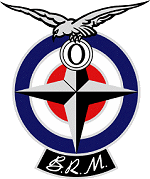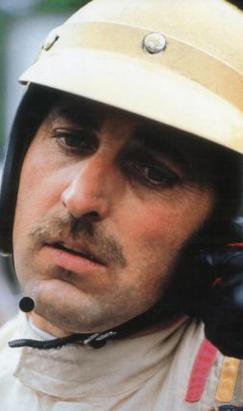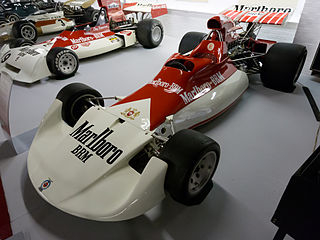
British Racing Motors (BRM) was a British Formula One motor racing team. Founded in 1945 and based in the market town of Bourne in Lincolnshire, it participated from 1951 to 1977, competing in 197 grands prix and winning seventeen. BRM won the constructors' title in 1962 when its driver Graham Hill became world champion. In 1963, 1964, 1965 and 1971, BRM came second in the constructors' competition.

Jean-Pierre Maurice Georges Beltoise was a French Grand Prix motorcycle road racer and Formula One driver who raced for the Matra and BRM teams. He competed in 88 Grands Prix achieving a single victory, at the 1972 Monaco Grand Prix, and a total of eight podium finishes.

Henri Jacques William Pescarolo is a former racing driver from France. He competed in the 24 Hours of Le Mans a record 33 times, winning on four occasions, and won a number of other major sports car events including the 24 Hours of Daytona. He also participated in 64 Formula One World Championship Grands Prix, achieving one podium and 12 championship points. Pescarolo also drove in the Dakar Rally in the 1990s, before retiring from racing at the age of 57. In 2000 he set up his eponymous racing team, Pescarolo Sport, which competed in Le Mans until 2013. He wore a distinctive green helmet, and wears a full-face beard that partially covers burns suffered in a crash.

Keith Jack Oliver is a British former Formula One driver and team-owner from England. He became known as the founder of the Arrows team as well as a racing driver, although during his driving career he won both the 24 Hours of Le Mans race and the Can-Am championship. Oliver was also the second person to complete the informal triple Crown of endurance racing.

Joseph Théodule Marie Schlesser was a French Formula One and sports car racing driver. He participated in three World Championship Grands Prix, including the 1968 French Grand Prix in which he was killed. He scored no championship points. He was the uncle of Jean-Louis Schlesser who himself became a Formula One driver in the 1980s.

Tom Belsø was a motor racing driver, credited as the first Formula One driver from Denmark.
Ensign was a Formula One constructor from Britain. They participated in 133 grands prix, entering a total of 155 cars. Ensign scored 19 championship points and no podium finishes. The best result was a 4th place at the 1981 Brazilian Grand Prix by Marc Surer, who also took fastest lap of the race.
Gilby Engineering was a British general engineering company and Formula One constructor owned by Syd Greene.

Anthony Hugh Leigh Trimmer is a British former racing driver from England, who won the Shell British Formula Three Championship and E.R. Hall Trophy in 1970. He was born in Maidenhead, Berkshire.

The 1958 Moroccan Grand Prix, formally the VII Grand Prix International Automobile du Maroc, was a one-off Formula One motor race held at Ain-Diab Circuit, Casablanca on 19 October 1958, after a six-week break following the Italian Grand Prix. It was race 11 of 11 in the 1958 World Championship of Drivers and race 10 of 10 in the 1958 International Cup for Formula One Manufacturers. It is the only time Morocco has hosted a World Championship Grand Prix.

The Fittipaldi F5 was a Formula One car for the 1977 Formula One season. It was driven by Brazilian Emerson Fittipaldi. The engine was a Ford Cosworth DFV, with the car achieving three of the team's 11 points from the season. The car was modified to become the F5A, which was used for the 1978 season and part of the 1979 season. Fittipaldi was the sole driver of the car in all three seasons. The car was succeeded by the Fittipaldi F6A.

The BRM P180 was a Formula One racing car, built by BRM and designed by Tony Southgate which raced in the 1972 Formula One season. It was powered by a BRM 3.0-litre V12 engine. One of the main features of the P180 was that the radiators had moved to the rear of the car, allowing the nose of the car to be very wide and flat. It competed in five World Championship Grands Prix, with a total of seven individual entries. The car scored no World Championship points, its best finish being eighth at the 1972 Italian Grand Prix.

The BRM P139 was a Formula One racing car designed by Alec Osborn, based on the original P126/133/138 design by Len Terry, which raced during the 1969 and 1970 seasons. It was powered by a 3.0-litre V12 engine. The car was uncompetitive, which resulted in team boss Tony Rudd being asked to resign, with his position being taken over by Tony Southgate, Tim Parnell and Aubrey Woods. After the team did not attend the French Grand Prix, a redesigned P139 appeared at the British Grand Prix, with a roomier, more bulbous cockpit and additional strengthening, giving the P139 a cylindrical appearance. The revised car was barely an improvement on the original P139, and was replaced by the P153 for the 1970 season. The P139 made one final appearance, at the 1970 South African Grand Prix, driven by George Eaton, who was effectively paying for his drive, and thus did not receive a 'works' P153.

The BRM P138 was a Formula One racing car designed by Len Terry which raced in the 1968 and 1969 Formula One seasons. It was powered by a 3.0-litre V12 engine.

The BRM P133 was a Formula One racing car which raced in the 1968 and 1969 Formula One seasons.

The BRM P201 is a Formula One racing car built by British Racing Motors and designed by Mike Pilbeam, which raced in the 1974 and 1975 seasons and in P201B specification in 1976 and 1977. The P201 featured a triangular monocoque, hip-level radiators, outboard front springs and inboard brakes. It used a 3.0-litre V12 engine and competed in 26 races, making 36 individual entries in total. Its best finish was second place for Jean-Pierre Beltoise at the 1974 South African Grand Prix, on the car's debut.

The Penske PC1 was a Formula One racing car developed and raced by Penske Racing during the 1974 and 1975 Formula One seasons. The car was designed by Geoff Ferris, and was raced by drivers Mark Donohue and John Watson. The PC1 entered and competed in 12 Grands Prix, and was replaced by the Penske PC3 in the 1976 season.
Heros Racing was a Japanese motor racing team which competed briefly in Formula One in the 1976 and 1977 seasons. The team entered the 1976 and 1977 Japanese Grands Prix, each time with local driver Kazuyoshi Hoshino with a best result of 11th in 1977. The team also competed in two races in the 1978 European Formula Two Championship and in Japanese top formula racing.
The BRM P230 was an open-wheel Formula One racing car, designed and developed by Aubrey Woods, and built by British constructor BRM, for the 1979 Aurora AFX F1 1979 British Formula One Championship, but never raced. It was due to be driven by Neil Bettridge, and like its predecessor was going to be powered by a nearly 500 hp (370 kW) BRM V12 engine, and run on Goodyear tyres. It later became the basis for the unraced BRM Hepworth GB-1 Can-Am car.
The BRM V12 engine is a V12 Formula One racing engine, designed, developed and built by British manufacturer and constructor BRM, between 1967 and 1977.















